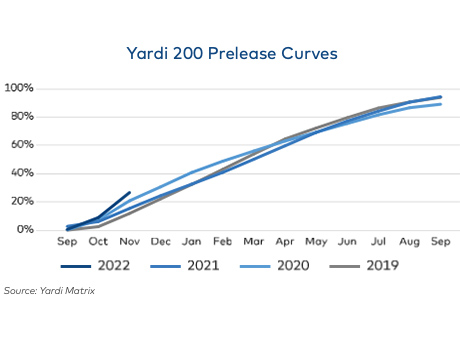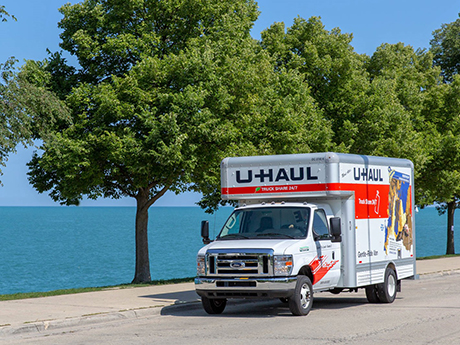Often lauded as a recession-resistant asset class, the student housing sector was able to add another feather to its cap over the course of the past year, proving that it is also pandemic-resistant. The fall 2021 pre-leasing period ended in September at an occupancy rate of 94 percent, up from 89 percent in 2020 and 0.4 percent from levels seen prior to the start of the COVID-19 pandemic in fall 2019, according to the Yardi Matrix National Student Housing Report January 2022. These numbers were seen within the company’s ‘Yardi 200’ markets, which include the top 200 investment-grade universities across all major collegiate conferences. Pre-leasing for the fall 2022 term is already underway with levels at 27 percent as of November — an 11 percent increase over the same time in 2020, and a 6 percent increase over levels seen in 2019. Yardi reports that the top five universities with the greatest year-over-year growth in percentage of beds pre-leased are the University of Wisconsin-Madison with 66 percent growth; the University of Nevada-Las Vegas with 48 percent growth; Purdue University with 43 percent growth; the University of Pittsburgh with 31 percent growth; and the University of North Carolina at Chapel Hill …
Features
By David Vincent, investment products specialist, Cadre Inflation is here to stay. November’s 6.8 percent jump in year-over-year consumer prices confirmed fears that rates would remain higher. Now, as investors seek out opportunities for sustained value and long-term growth under changing conditions, hard assets like real estate may become even more appealing. After all, commercial real estate has proven to be an attractive hedge against inflation over the last 40 years. Most experienced investors understand that holding on to your money with the old cash-under-the-mattress technique sadly offers no protection in inflationary periods. Prolonged price increases ultimately erode the value of consumers’ purchasing power. The money you’re sleeping on (or, more realistically, keeping in a low-rate bank account) is steadily losing its real value. As prices rise over time, the amount of goods and services you’re able to purchase with that money is decreasing. Higher-than-expected inflation can also have negative consequences for stocks and bonds. A historical study by economists Fama and Schwert demonstrated that a 1 percent increase in the rate of inflation typically causes bond prices to drop by approximately 1.5 percent and stock prices by 4.2 percent. In contrast, inflation may have a positive impact on physical …
InterFace Panel Names What’s Hot for Social Media Marketing in the Student Housing Sector
by Katie Sloan
DALLAS — It comes as no surprise that digital marketing — and chiefly, marketing via social media — is one of the best ways to reach potential new renters in the student housing space. Students spend a massive amount of their downtime scrolling through various social media platforms, from TikTok to Instagram. And while a focus on digital marketing within the sector has been seen for some time, the COVID-19 pandemic brought an even greater emphasis on the space by eradicating opportunities for traditional marketing methods such as in-person events and tours. In December, a panel of marketing specialists discussed what’s hot and what’s not for social media marketing at InterFace Conference Group’s third annual LeaseCon/TurnCon conference in Dallas. According to a 2021 survey noted by panel moderator Alison Slager, national business development executive for LeaseLabs by RealPage, 79 percent of marketers used paid ads across social media platforms. With marketing budgets tightening, it’s important to know what resonates with today’s students to ensure all marketing dollars are well spent. Instagram Panelists agreed that the most dominant social media marketing platform is currently Instagram, particularly with its recent addition of Reels, a tool which allows users to post short-form videos. “Instagram …
PHOENIX — Florida and Texas dominated the list of top 25 growth cities highlighted in the U-Haul Growth Index, an annual metric tracked by the Phoenix-based moving giant. Together, Florida and Texas accounted for 15 of the top 25 markets for one-way U-Haul moving trips in 2021. Kissimmee-St. Cloud, a Central Florida metro situated less than 30 miles south of Orlando, came in at No. 1 for 2021 after finishing second in both the 2019 and 2020 rankings. Rounding out the top five in-migration markets for 2021 are Raleigh-Durham, N.C.; Palm Bay-Melbourne, Fla.; North Port, Fla.; and Madison, Wis. Arrivals of U-Haul trucks into Kissimmee-St. Cloud climbed 31 percent from 2020, while departures rose 29 percent. Arriving trucks accounted for 53.2 percent of all one-way U-Haul traffic in Kissimmee-St. Cloud, which was one of Florida’s 10 markets in the 2021 list. “Florida remains competitive, especially during the COVID era,” says Miguel Caminos, president of U-Haul Co. of Orlando. “We’ve pushed through and business is thriving. It’s not just people moving to Florida, but businesses moving because they see better opportunities here.” “Florida has always been a destination location for retirees, but more so (in 2021), a lot of people took …
The COVID-19 pandemic changed the ways schools operate, how classes were taught, and how students learned and socialized in 2020. Life still hasn’t returned to normal for anyone, including students away at college. Interior design may seem like a lower priority in the wake of such a health crisis, but these professionals would argue the exact opposite — that it’s more important than ever. That’s because leasing, retention, and making students and parents feel safe and secure as they return to their college experiences is more important than ever. The pandemic shifted higher education from in-person classes to online learning in 2020. This gave students and parents an entire year to reassess whether going away to school was the right decision going forward. This has been compounded by a focus on increasing education costs, as well as many colleges announcing that the 2021 to 2022 school year would emphasize hybrid learning, with lots of classes remaining online as the Delta variant took hold. The cumulative result of all this was a 4 percent decrease in undergraduate enrollment in 2021, per the National Student Clearinghouse Research Center. Freshman enrollment for the fall 2021 semester start sank by 13 percent when compared to …
PHILADELPHIA — Operators in the seniors housing industry have long been awaiting the incoming demographic wave of baby boomers reaching retirement age. Every day in the U.S., 10,000 people turn 65, and the number of older adults will more than double over the next several decades to top 88 million people and represent over 20 percent of the population by 2050. The oldest boomers are now 76. But this wave of customers will have very different desires than existing seniors housing residents, according to Tod Petty, chief operations officer at Lloyd Jones Senior Living. “We know demographics and psychographics are rapidly changing. Think of the success of The Villages [a famous retirement community in Florida]. They’re drawn to live their best life. It is the last hurrah for many people to be relevant.” Petty’s comments came during a panel titled “The Development Outlook: Experts Analyze the Smartest Plays for Developers in 2022” during France Media’s InterFace Seniors Housing Northeast conference. The event was held in Philadelphia on Dec. 2. Petty moderated the panel, which also included Stephen Bailey, senior vice president of new business development, Kendal Corp.; Michael Gordon, senior vice president of acquisitions and development, EPOCH Senior Living; Scott …
ATLANTA — Multifamily investors increasingly view Atlanta as a tier-one market. Speakers on a panel at France Media’s InterFace Multifamily Southeast conference, held in Atlanta on Dec. 2, point to several reasons why the region is the right place, right now, to build, buy and sell all manner of apartment assets. “In Atlanta, you’ve got an incredible diversity and strength of employers,” said Chad DeFoor, senior director of multifamily sales for Franklin Street. Total nonfarm payroll employment in metro Atlanta rose by 134,800 from October 2020 to October 2021, a 5 percent increase, according to the U.S. Bureau of Labor Statistics. DeFoor was joined by Bianca Tabourn, managing director with Stockbridge; Steve Baile, chief development and operating officer with Selig Enterprises; Patrick Chesser, managing director of Mill Creek Residential Trust; Seth Greenberg, CEO of ECI Group; and panel moderator Jason Nettles, managing director with Northmarq. The speakers in the session titled, “Atlanta Market Update: An In-Depth Look at Leasing, Investment and Development,” all remarked that job growth and high-profile employers moving into the area are, in part, helping to curry favor among investors. In the public and private realms, interest is growing in the apartment market in Atlanta and in …
Content PartnerDevelopmentFeaturesLeasing ActivityMidwestMultifamilyNortheastSoutheastTexasWalker & DunlopWestern
2021 Multifamily Housing Market Outlook Shaped by Growth Trends, Housing Prices
COVID Disrupts Markets Again The country began breathing a sigh of relief in the second quarter of 2021 as U.S. GDP returned to pre-pandemic levels. With a substantial part of the U.S. population vaccinated, the unemployment rate plummeted, schools began preparing for in-person instruction and restaurants were back in business, again surpassing grocery sales in volume. But just as things seemed to be returning to “normal,” the delta variant of COVID began to spread. New COVID cases turned into rising COVID deaths by August,[1] disrupting supply and demand chains. Consumer confidence, which had been rising since hitting a low in April 2020, dipped to a new low point in August; consumer spending stalled[2], and fewer people traveled by plane[3] or returned to the office[4] that month. While economic growth remains positive, the delta variant, now accounting for almost all new COVID cases[5], again introduced market uncertainty, resulting in a 4 percent drop in stock market pricing in September. However, as COVID cases began declining in mid-September, stock prices began to rise, erasing the September drop in October, and resulting in a 22.6 percent gain for the year. Overall, economists maintain strong economic growth expectations of 6.1 percent GDP growth for …
Apartment Leasing, Management and Operations Continue to Adapt to Market Needs, Says InterFace Panel
ATLANTA — For the past few months, the apartment sector has been in an upswing from an owner and operator perspective. Rents are rising and occupancy rates are high. However, some fear that these positives in the real estate market are going to be short-lived and eventually come to an end. Kevin Owens, division president of RPM Living, said that when the hottest geographic markets start to slow down, then other markets are going to follow suit. “Boise, Idaho is the hottest market from a rent growth standpoint in the country for the last few months, and it took a hit in November. So, if the hottest markets are going to start slowing down, then other markets are going to start slowing down. It’s just a natural progression,” said Owens. Owens’ comment came from a panel titled: “A Report from the Frontlines: What is the Outlook for Leasing, Management & Operations in 2022?” The discussion was one of the many that occurred at France Media’s InterFace Multifamily Southeast conference at the Westin Buckhead hotel in Atlanta on Dec. 2. The panel experts included moderator Craig Thompson, partner at Carr, Riggs & Ingram LLC; Kevin Owens, division president of RPM Living; …
AcquisitionsBuild-to-RentContent PartnerFeaturesLeasing ActivityMidwestMultifamilySingle-Family RentalSoutheastTexasWalker & DunlopWestern
Multifamily Investment Sales Strong in Southern States; Gaining More Interest in Midwest
Multifamily investment benefitted from the uncertainties of the past year, but will the transaction volumes of 2021 be used to gauge the likely outcomes for 2022? Managing directors Todd Stofflet and Jason Stevens of Walker & Dunlop’s Chicago office review 2021 and what the trends of this year indicate for the direction of the industry. REBusiness: What have you seen regarding multifamily investment activity this year? Stofflet: Early in the pandemic, we saw a lot of investment pull away from retail and office, focusing more on industrial and multifamily. In 2021, the multifamily sector has fared very well and a lot of new investors have entered the multifamily market. If you talk to some of our colleagues in the Southeast and the “smile states,” they will tell you that transaction volume has never been higher and the amount of capital chasing these opportunities has never been bigger. Across the country, it has been a very strong year for the sector. REBusiness: Do you think 2021 will be a record year in terms of sales? Stevens: If our pipeline is any barometer for that, the answer is “absolutely,” but it will be market dependent. What you’ll find is that sales in …











